THE ART OF PIANO
2010年03月24日

Here it comes again, the 2nd Takamatsu International Piano Competition 2010! This is a becoming prestigious and a biggie in the piano and classical music world and will be held in the very plush and beautiful, multi tiered Sunport Concert Main Hall in Takamatsu City. The venue really is new, modern and great. Right near the water, the smell of the sea and a stone throw from the Central Takamatsu JR Station.
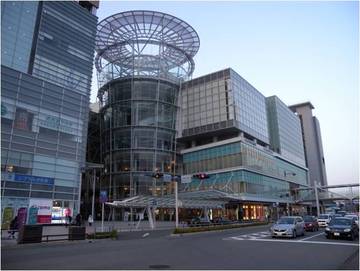
Sunport Concert Main Hall in Takamatsu City
Already a springboard competition for pianists getting ready for, or trying to break into the international classical music arena. The first prize is a cool ¥1,000,000, 500,000 for the runner-up and 300,000 for the third place. Previous winners such as Pave Gintov, Stanislav Khristenko and Chao Wang have all gone on to successful careers as professionals or semi professionals. So crack those knuckles and get those scales up to speed. There will be lots of Haydn, Listz and Mozart and …Oh? The deadline has expired? Well that’s probably lucky for anyone who’s heard my feeble piano efforts.
For the contestants there will be four rounds, each with pieces selected from a menu of classical repertoires in etude or sonata form. The second 40 minute round with the previous sonata finished in its entirety. Contestants are free to choose which movement in the first round … In the third round, any one of 4 Mozart concertos performed together with a symphony orchestra. After this, a six minute mystery piece composed by Ken Fujimitsu which nobody quite knows how it goes ? (hum a few bars please Ken? I won’t tell?) All finalists must play this one piece.
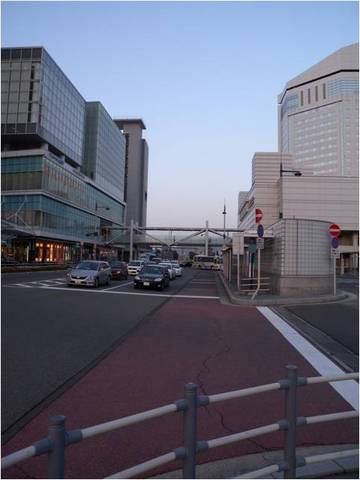
The competition has been opened to anyone up to age 40, which means I’m too old by just one year, damn.
For visitors to Takamatsu it will be an opportunity to see this wonderful place, which has a lot of venues for the arts including the Anabuki Citizens’ Hall, which is also another world-class facility for music and close to Sunport. This hall also holds live performances of any genre.
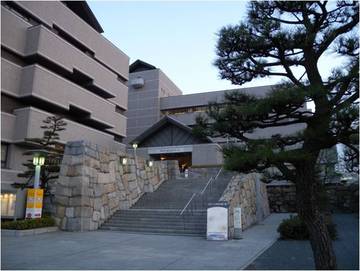
Anabuki Citizens’ Hall
On another note, (excuse pun) there’s a lot of other interesting architecture in Takamatsu and some world-famous buildings from different eras such as the Citizens’ Sports Center built in 1968 is just one.

Citizens’ Sports Center
The Sunport facilities are all very central and near the waterfront as mentioned. This allows easy access to the many islands in the Inland Sea area (Setonai Kai). Shodoshima, Naoshima are just one hour away and the port’s ferry ticket offices are just a few minutes on foot to the east of the Central Station.
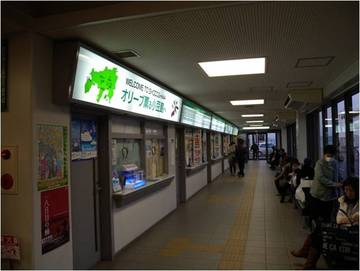
Ferry ticket offices
From the entrance of the Sunport Hall just walk twenty or so meters to the end of this street to see the port and the vehicular/passenger ferry facilities.
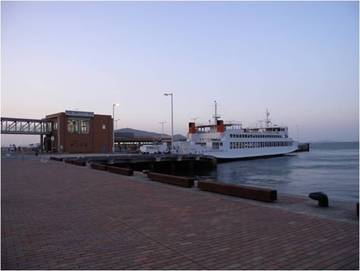
Vehicular/passenger ferry facilities
THE ART OF PARKS
2010年03月18日

Tamamo Park is another favorite place of mine and now that Spring has arrived, the annual sale of trees, plants and shrubs there by vendors has started. This is known as a “sea castle” and there are only a few in Japan. 80,000 square meters and built in 1590 for the Ikoma family, later ruled by the Matsudaira family for 11 generations and who ruled Sanuki (Kagawa) for 228 years.

TamamoPark
It’s so close and central and such a relaxing place to be for reflection, meditation or just simple good old peace-and-quiet. We can see the history museum right next door, too. I heard there are a few categories of Japanese parks and this one, like Ritsurin its world famous peer has ‘aspects’ that change every few meters.
Walk twenty meters or so and you’re in a different aspect. A different park … at times, totally different actually. So please keep this intentional design feature in mind when you’re walking around.
For me, the park has the most beautiful stonework from the remains of the castle once there. I took some photos, which I hope will show this lovely balance of soft and hard. Plants, trees and against stonewalls softened with such graceful curves as they meet the ground.
The at times, greenish colored stones themselves have weathered and slightly rounded their edges over the centuries. This used to be a place with lots of moats. Tons of them, so water is still a central part of its ‘aspect’ and overall design. 3 big ones in fact, an outer, middle and inner moats so there’s a lot of water and sluices and sluice gates for controlling all this water. They must have felt very threatened in those days? Or very secure? Can’t figure out quite which … both? It does explain the signs references to traditional Japanese swimming, which must have been practiced in the inner moat. (My conjecture)
On the south side are the last intact remains of the old castle’s turret or guardhouse and it’s beautiful to sit there and look at the park, cherry blossoms and to the north, the Inland Sea.

Tamamo Park also has apart from a lot of moats and water, some beautiful Tasiho era buildings, which still serve the public with occasional exhibitions, tea ceremonies and concerts.
The park operates all year but opening times may vary seasonally. But it usually opens from 7:00 A.M until 5:00 P.M. It’s directly across from the Central Takamatsu JR Station and about 5 minutes on foot. Tel: 087 851 1521 You’ll need a Japanese friend to advise you of the events being held there, so do take the time to find out as there have been some great bonsai exhibitions, moon-viewing parties etc. in the past.
There are quite a few signs in English explaining the history of the place and this makes it friendly for English speaking visitors.
Entrance fee: 200-yen adults. Children 160-yen. Cheap.
At the moment, there’s rebuilding going on of one of the stonewalls on the south side. Nobody has a clear idea of the exact scale and dimensions of the previous castle most of the old records have been lost. Sad …
THE ART of ART #2
2010年03月11日

One of the pleasant surprises Takamatsu City has to offer is a very beautiful multi-storied monolith that is the gallery. It’s an exercise in modern, clean design and one of the most visitor- friendly galleries I’ve ever been to. Walking in the entrance the spaciousness of the first floor is immediately calming and beautiful. Alright, OK, so lots of people just go to the annexes there to sit in the Miles Van der Rhoe ‘Barcelona chairs’ and snooze away the afternoons. But it looks a pretty attractive and cool idea to wile away hot summer lunchtime if you ask me …

Times: 9:30~7:00 weekdays. 9:30~5:00 weekends and holidays.
But to the point, it is a very modern, spacious and interesting place built in 1988 with mezzanine floors, resting rooms, great library and some super traveling exhibitions doing the rounds through the year. The Takamatsu City Gallery is plonked upon the most expensive piece of real estate in the city. Right smack bang in the very center of the CBD and this speaks volumes about the Japanese and their love of the arts I think. I have only one criticism of this place that I spend a lot of my time, and that is their interesting web page is only in Japanese, to wit, not very ‘other language friendly’. But this can be fixed with a bit of effort, as this is especially frustrating when one reads in Japanese about the non-exhibition art activities available for all the people living in Takamatsu to partake in and enjoy.
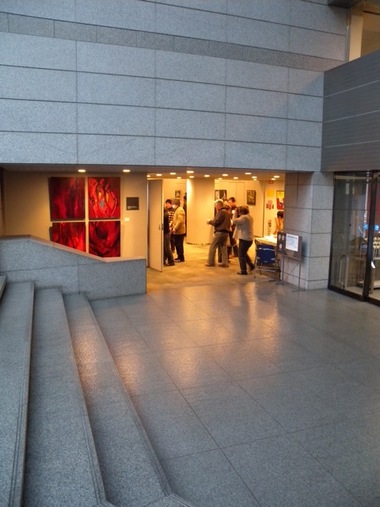
http://www.city.takamatsu.kagawa.jp/kyouiku/bunkabu/bijyutu/
http://www.city.takamatsu.kagawa.jp/english/sightseeing/sees/takamatsu-city-museum-of-art.html
Location map on the link above.
Another well designed and newish gallery built in 1992 is the Takamatsu History Museum and this is another startling piece of clever architecture, beautifully thought out and a joy to walk through. Again, they have some great exhibitions during the year but frequently with little if any information in English, (or any other foreign language) sorry to labor the point… It is very centrally located and right behind the large Anabuki Concert Hall and underground parking is a big help for drivers.
Last year’s exhibition on the changes in Japanese and in particular Kagawan’s lifestyle over the last 60 years was a winner. This featured a mock up of a kitchen from the 40s, working TVs from the 50s, comics and animation from the 40s, old technologies such as early cameras, videos etc. There were even some old stores built to replicate the atmosphere of the times.
In the permanent exhibition which features many Buddhist scrolls, objects of devotion and paintings (this really needs someone at hand to explain, as it’s esoteric stuff) but there is a reconstruction of a cabin from the “Hiryu Maru”. The cabin shows us how the lords of another age traveled by sea. Gee, I thought it would be pretty swank to travel like that even these days?
http://www.city.takamatsu.kagawa.jp/english/sightseeing/sees/takamatsu-history-museum.html
It’s a world-class facility without a doubt and five minutes on foot from the Takamatsu Station.




